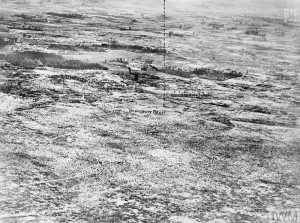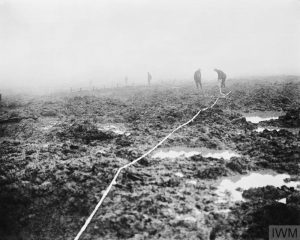At 3:50 AM on July 31, 1917 the Third Battle of Ypres began. The 8th Queen’s were in the front lines of the attack of the 24th Division advancing towards the Gheluvelt Plateau. So, one hundred years ago today, Jack Peirs and his men were fighting at the start of one of the most important battles for the BEF on the western front.
First some background. The July 31st attack was the beginning of three months of offensive operations by the BEF at Ypres. It was the third major battle fought on this contested ground, a landscape which bore the scars of years of war; extensive trenches, concrete pillboxes, and innumerable shell craters prone to flooding. Often referred to as the Battle of Passchendaele (a later battle in the overall offensive), Third Ypres has been subject to debate since it was waged, in part, because of the abysmal conditions for front line units and the weariness of the soldiers doing the actual fighting. Edmund Blunden recalled with frustration feeling at the time that ‘ We should all die, presumably, round Ypres’ (Blunden 165).

Shrewsbury Forest – where the 8th Queen’ attacked. Photograph (Q 55511) Aerial photograph of Shrewsbury Forest, no 7819, Sheet 28.1.30. Date 7 July 1917. Copyright: © IWM. Original Source: http://www.iwm.org.uk/collections/item/object/205305167
On 31 July, though, the months of hard fighting ahead were unknown. All that Major Jack Peirs knew for certain was that the 8th Queen’s were to have a role in the opening attack. They were charged with assaulting two German trenches – known as ‘Jehovah’ and ‘Jordan’ trenches – and holding their position until relieved. For this task, the 8th Queen’s trained extensively.
Indeed, there is a useful contrast between training and fighting in 1917 compared to that in 1915, a contrast that demonstrates both learning and the increased sophistication of fighting on the western front.
When the 8th Queen’s first went into battle at Loos in 1915 they did so in an attack that by any standards was a botched affair. Their division was given a hurried order to attack a formidable German position; they had no written orders and only a basic understanding as to what they were supposed to do (attack the Germans). It was a complete disaster. At the time (and afterwards) Peirs believed that ‘the staff’ had let them down.
A lot changed on the western front between September 1915 and July 1917. As the fighting increased in scale and severity, so too did staff work increase in its sophistication, so that 1917 the BEF was training for set piece battles fought with specific objectives in mind. Men were trained in new weapons (bombs, rifle grenades, Lewis guns) and learned how to assault fixed positions behind artillery support. In July 1917, the 8th Queen’s spent substantial time training for their attack.
- July 1-6: the battalion spent five days in general training.
- July 7-11: the battalion spent five days in tactical weapons training with bombs, Lewis guns, and rifle grenades.
- July 12: the battalion was issued with orders that they were to attack at Klein Zillebeke (Belgium). These orders detailed the objectives, the order of battle (who would fight where and when), the methods of attack, and the equipment to be used.
- July 15-16: the battalion trained on a flag course for their attack. The course was a behind-the-lines mock-up of their intended attack. The battalion then moved between various staging camps.
- July 24-25: further training. The battalion trained and reconnoitered the front line.
- July 29: the battalion went into the trenches for their attack.
- July 30: rest (day) and then moved into assault positions at night.
- July 31: attacked.
As dawn approached on 31 July, the 8th Queen’s were in their assault positions. These positions had been marked with tape by Major Peirs the night before.

THE BATTLE OF PASSCHENDAELE, JULY-NOVEMBER 1917 (CO 2253) Assault on Passchendaele 12 October – 6 November: Canadian Pioneers laying tape through the mud for a road to Passchendaele. Copyright: © IWM. Original Source: http://www.iwm.org.uk/collections/item/object/205193444
The 8th Queen’s took casualties from German shelling at the tape line before the British barrage began at 3:50 AM. As soon as the British barrage began, the Germans countered it with accurate shellfire upon their position; there was a lot of metal in the air and the ground shook with concussions. At 3:54, Peirs and his men advanced behind a creeping barrage towards Jehovah trench. It took them nearly an hour to take their first objective; their advance was hampered by rough, boggy ground, as well as German shelling. But they took it easily all things considered.
The 8th Queen’s then moved on to their second objective, Jordan trench, which they also took easily despite casualties from German artillery. At this moment Peirs became worried about his position. The 8th Queen’s moved farther forward than the units on his right and left and his flanks were exposed. The companies on the right and left dug in and consolidated their strength, connecting the two captured German trenches with existing shell holes.
In taking these positions, they suffered casualties; there were dozens of wounded men that had to be collected and evacuated by stretcher if possible. German artillery had been active since zero hour and continued to punish the 8th Queen’s throughout the day and into the evening. At night approached heavy rains added a certain miserable element for men who were already feeling the strain of sleeplessness, fatigue, and fear. They held this position for another long day of rain and shelling before being relieved by the 9th East Surreys.
Peirs and his men certainly did their part and followed their operational orders to the letter. They assaulted two German trenches – taking both – but suffered significant casualties. The three days of movement, fighting, and shelling cost the 8th Queen’s the following: 3 officers and 32 other ranks killed; 9 officers and 156 other ranks wounded; 105 men missing. They had certainly earned a rest.
Sources:
Edmund Blunden, Undertones of War (New York: Penguin, 2000)
